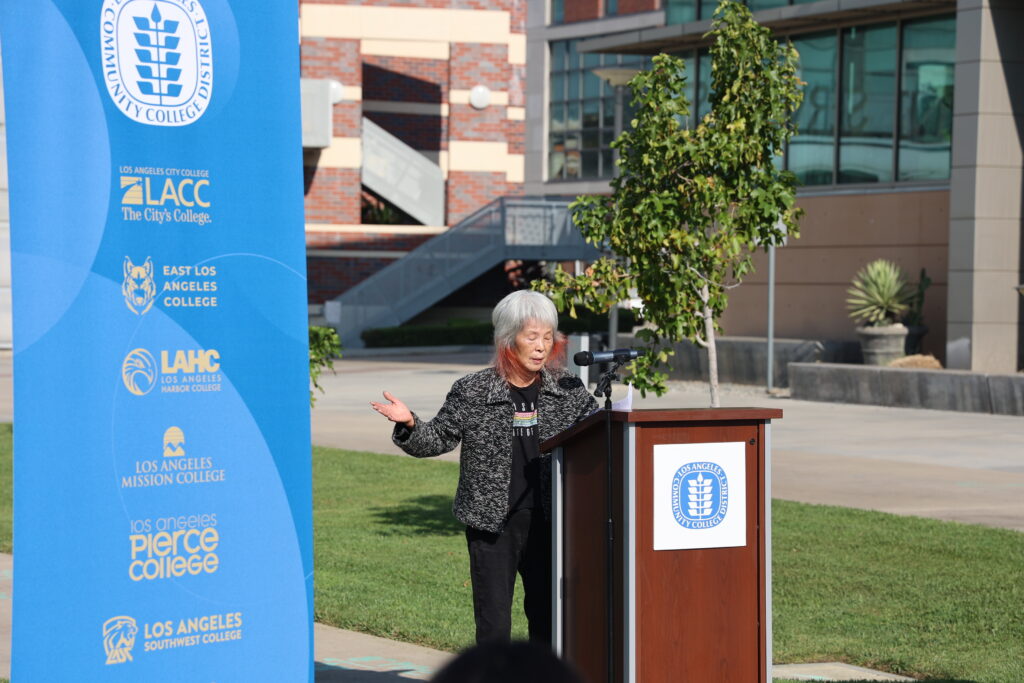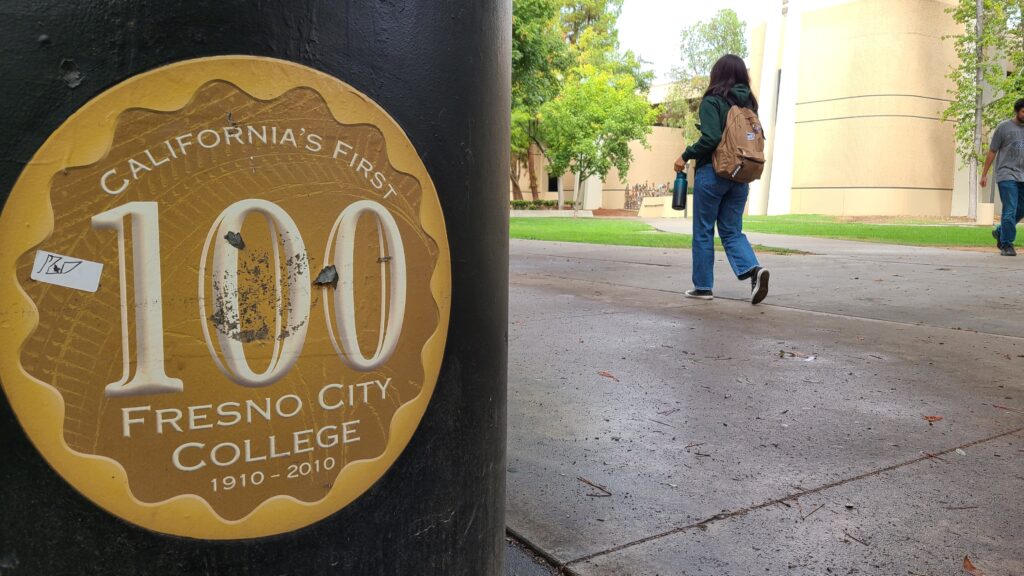A would-be intruder would have a difficult time trying to sneak into the new Del Sol High School in Oxnard, which opened in August with its first group of 475 first-year students.
That’s because the $189 million campus was planned and built with security at the top of the list of concerns, officials say. And that puts it at the forefront of a trend throughout California and the nation as school districts respond to school shootings and try to prevent any more violence.
At Del Sol, two perimeters of 8-foot-high black fencing — designed to deny a foothold to potential climbers — surround the campus and fill in openings between the buildings’ edges. After incoming students file through Del Sol’s two gates under the watchful eyes of campus employees, the only entry is through a glass cube-like lobby. There, visitors are screened carefully from behind a bulletproof glass window and, if approved, admitted through a locked metal interior door. Cameras survey the courtyards and exterior walkways. Coming soon is a new schoolwide door-locking system for emergencies.

“Nowadays safety and security are the first priority. The rest follows that,” explained Oxnard Union High School District Superintendent Tom McCoy on a recent tour of the school, which opened this fall. Many of the same safety features built into the new 47-acre campus are being added as retrofits where possible to the district’s 11 other high schools and one adult school. That includes Hueneme High School, where 22 years ago, a teenage gunman took a student hostage but was soon killed by a police sniper while the hostage was saved.
Throughout the nation, new schools are being designed — and older schools retrofitted — to make them as safe as possible for students and staff and as difficult as possible for a potential assailant to gain entrance and cause deadly trouble. Those features often include a single point of entry, new fencing, limited visibility into classrooms, bulletproof glass in vulnerable spots and new alert and locking systems.
McCoy and educators and architects throughout the state and country say the challenge is to make a school safe without making it look like a bunker or penitentiary. They say Del Sol and other campuses succeed in showing that a pleasant and secure learning environment can be created.

“It’s a fine line,” Del Sol principal Terri Leon said. “We want our kids to feel safe, but we don’t want them to feel imprisoned. I think (the design) does a good job of balancing that. Our kids seem to like the design and the spaces and how everything is set up. But then we are pretty secure.”
The campus was designed by the PBK architecture firm, which has nine offices throughout California. So far, the school consists of eight buildings, mainly two stories and connected by walkways. All share plenty of outdoor space and plazas. Corridors and classrooms have large windows, providing much light and views of mountains. Students can present projects or hold meetings in big, flexible interior spaces. While a sense of openness exists inside the campus, there is no mistake that the exterior’s decorative black metal mesh fence presents a strong impression of do-not-enter to an uninvited visitor — even without old-fashioned barbed wire or chain link.
In California, many older schools were built when openness and a sense of freedom were important, taking advantage of the climate with unprotected breezeways, unfenced lawns and multiple easy entries. School officials and architects and parents say they don’t want to entirely lose that, at least inside secure perimeters.
“Security is on everyone’s minds,” said Michael Pinto, design director at NAC Architecture firm’s Los Angeles office, which has worked on many school projects with anti-crime features. “It is really a concern of parents. And when someone is concerned about the safety of their children, there is nothing you can do but respect that and take those concerns seriously.”
That does not mean designing a dark, windowless bunker or having excessive fencing, said Pinto, whose projects include the current rebuilding of the century-old Belvedere Middle School in East Los Angeles. Belvedere’s new buildings were placed to form much of the campus’ exterior boundaries. As a result, the amount of fencing is actually reduced from the old arrangement, according to Pinto. Meanwhile, inside the campus, students get a lot of outdoor space and light.
“We don’t want hermetically sealed schools,” said Pinto, who served on the Los Angeles city attorney’s commission on school safety. That panel’s 2018 report called for improved security measures like single entries, along with better mental health services and more societal gun controls. The federal government has issued similar guidelines that emphasize clear sight lines and access control, along with clean and upbeat school environments.
The Saugus Union School District in northern Los Angeles County recently spent much of a $148 million bond issue for security measures at its 15 K-six schools. Those include new single-point-of-entry lobbies with secondary locked doors leading into the campuses, better fencing and lighting, new door-locking systems and window shades that can be closed in an emergency. Identification letters and numbers have been painted on roofs so police or fire crews can see them from the air and get to the right location quickly in an emergency, according to Nick Heinlein, the district’s assistant superintendent of business.
The goal is to make campuses “as safe as we can make them without them seeming unappealing,” Heinlein said.
The need was brought home by a tragic 2019 episode at Saugus High School, a hometown campus run by a separate district, Heinlein said. A student armed with a pistol shot five schoolmates, killing two, before killing himself. When something like that happens, “there is always something that can be learned,” Heinlein said. Among other things, changes were made to allow students to flee if necessary through campus exits with panic bars that can be opened from the inside or that can be easily unlocked by adults in an emergency, he said.
Responses to school violence go beyond architecture and window panes. Staffs are getting better trained on how to lead lockdowns, evacuations and student drills. Campus and municipal police are being better trained for a faster response to shootings, searching quickly for assailants and being well-armed enough to counter them. Schools look more closely for students’ behavioral and emotional problems that could escalate. Mental health resources have been boosted, as have methods of reporting threats.
Architecture and engineering help a lot, but they aren’t sufficient without other efforts, according to Scott Gaudineer, who is president of the California branch of the American Institute of Architects, a professional organization representing 11,000 architects in the state. “Human intelligence is just as important,” said Gaudineer, who also is president of the Flewelling & Moody firm, in the Los Angeles area, which has worked on school projects. “Schools must keep a watchful eye and offer counseling to a student “who is going through a divorce, who is stressed.”
“The challenge is you never know who is going to show up with an AK-47 and is mentally deranged. It is shocking how often this is happening,” he added.
Two of the most infamous school shooting sites have taken different approaches in the aftermath. In Connecticut, the Sandy Hook Elementary School was demolished in the wake of the 2012 rampage that left 20 children and six educators dead. A new school was built with a moat-like rain garden around it, bulletproof windows and an elevated first floor to make it harder to see in.
In contrast, Columbine High in Colorado remained pretty much the same after the 1999 assault, during which two students killed 12 classmates and one teacher before committing suicide. Some new security measures have been added such as more fencing.
McCoy, the Oxnard Union superintendent, has personal experience encountering violence. In 2001, a troubled teenage boy who was not a student there easily got into Hueneme High School. McCoy, a vice principal then, escorted him off the grounds. The intruder came back, holding a female student at gunpoint as he entered a campus quad through an unguarded gate. A police sniper shot and killed the gunman, and the girl was not wounded.
McCoy, who was nearby but did not witness the shooting, said its lessons are reflected in Del Sol’s design and in improved emergency sheltering and evacuation procedures. Adult staff, he said, must be prepared since “the kids look to the adults immediately and follow our directions.”
During the tour, McCoy pointed out what he said is one of the most important anti-violence features: a wellness center, a big sunny room with beanbag chairs where students under emotional stress can chill out and meet with a counselor. “If they are having a bad day, instead of acting out in the classroom, they can hang out here and spend the time they need and go back to class,” he said. About 60 students a day spend at least some time there, usually at lunch.

Credit: Julie Leopo / EdSource
Eight-foot wire gates surround Del Sol High School in Oxnard on Oct. 3, 2023.
Del Sol, built on a former strawberry and citrus farm in the eastern part of Oxnard, serves a predominately Latino and low-income population, including some whose parents work in the fields. As additional classes enter each of the next three years and the current freshmen become seniors, enrollment is expected to grow to about 2,100 students.
The land cost $25 million, and construction bills so far total $194 million, including $30 million to the city for street improvements, funded by bonds, certificates of participation and other sources, according to McCoy. Athletic fields are being finished to the rear of the site, and plans call for a performing arts center, swimming pool and football stadium to be added when more state or local funds can be found.
The contemporary-style buildings are clad in complementary panels of gray, cantaloupe and white. The black metal fencing has narrow vertical openings that make it nearly impossible to get a foothold, but there are no barbed wire or top stakes that could hurt a student who tries to climb out, according to Mark Graham, its principal architect, at the PBK firm. The company has installed similar security measures at the new $200 million Chino High, which opened last year, and at retrofits at three campuses in the Cucamonga School District in San Bernardino County.
The fence aims to look porous, Graham said. “We wanted to use something that didn’t look so penal. It is there, but it is not like you are being caged in.” Going fenceless is not an option on most school projects these days since security is “at the top of the list of concerns, especially for parents and school board members.”























